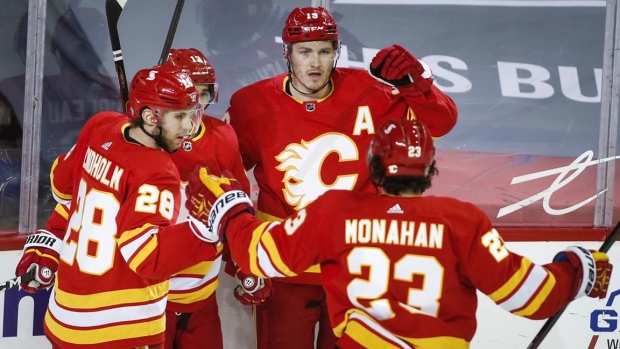Nov 11, 2021
Calgary’s core delivering in a big way
A dominant top line and Darryl Sutter’s old playbook have the Flames flying early, Travis Yost writes.
By Travis Yost

Connor McDavid, Leon Draisaitl and the Edmonton Oilers have been the most electric group to watch this regular season. But their provincial rival in Calgary has also quietly put together one of the league’s most dynamic lines in the form of Johnny Gaudreau, Elias Lindholm, and Matthew Tkachuk.
Lindholm has been a part of the Flames organization for four seasons now, but Calgary has been reticent in prior seasons to put this trio together. Prior to this season, the trio played together sparingly – the Flames were particular about playing Gaudreau with the likes of Sean Monahan, whereas Matthew Tkachuk would regularly see minutes with Andrew Mangiapane and Mikael Backlund.
This season? It’s quite different, intentionally:

Three things have made it easy for the Flames to assemble and sustain this lineup. Number one, they are healthy. Number two, they have been exceptionally strong out of the gate, posting a 7-2-3 record and +15 goal differential – the type of numbers that chill any notion of coaches playing around with different line combinations and deployment strategies. Number three, and most importantly, the line has been outrageously good.
If we compare this Calgary line to some of the other groups (90 minutes or more at even strength to start the year), they stand out in remarkable fashion. They have outscored their opponents 7-0 (+7) in 140 minutes together, and expected goals – blind to the fantastic goaltending they have received from Jacob Markstrom (.940 stop rate this season) – still have them outscoring the opposition on a 2-to-1 basis:

It’s one thing to have incredible puck luck in the offensive zone or have a white-hot goaltender back-stopping you for a 10-game clip – it will almost always lead to a lofty goal differential and have a meaningful impact in the standings. But those shooting and save percentages are often fleeting: Tkachuk of 2018-20 (90.5 on-ice save percentage), as one example, would have loved Tkachuk of 2021-22 (98.7 on-ice save percentage).
That’s why the expected goal numbers underpinning that strong early season goal differential is so important. If you watch this line play, you notice three things: they dictate the run of play in the neutral zone, they are generating shots from the interior in the offensive third and have been outstanding at pushing opposing shooters to the perimeter when they are playing off the puck.
On the defensive side of the ice, head coach Darryl Sutter – who ushered in the cutthroat, lock-it-down defensive structure in Los Angeles years ago – has rotated his big line with both of his key defensive pairings, balancing ice time across Rasmus Andersson, Noah Hanifin, Chris Tanev, and Oliver Kylington.
The five-man units have combined to create the most impressive shot profiles you will find over the first month of the season – something that is eminently more sustainable long-term than Markstrom stopping every shot he’ll ever face (via HockeyViz):

The Flames are finding success with Sutter’s old playbook, which is one of the most tried-and-true playbooks in the league – if you dominate control of the puck and win heavily on shot volume, the goal differentials will follow.
If that recipe includes high-end finishing (like those puck-dominant Detroit Red Wings once had) or stifling defensive play (like Sutter’s old Kings teams had), that’s when you start talking Stanley Cup-calibre hockey.
We are a way off from comparing this year’s Flames to teams of that ilk. But two things certainly appear true early on: Sutter’s puck-dominance is manifesting itself once again, and Calgary’s core is delivering results in a big way.
Data via Natural Stat Trick, Hockey Viz, Evolving Hockey, NHL.com

